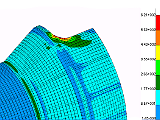The Sobriety company has become the part of a consortium of seven companies and academic institutions from the European Union, which stands behind the S.H.E.E. project (Self-deployable Habitat for Extreme Environments). This project is based on the current technology research to design a folding self-deployable unit for use in extreme conditions, or areas affected by natural disasters. The S.H.E.E. unit, whose viability will be verified by Sobriety computer simulations, must be able to satisfy basic needs of its inhabitants, recycle water and produce electricity.
Links :
S.H.E.E. webpage:
www.shee.eu
Article about project S.H.E.E. on the Space Safety Magazine:
S.H.E.E. Brings Space Architecture to Earth: Pan-European Consortium Launches an Innovative Project
DOULE, O.; IMHOF, B.; HOHENEDER, W.; WEISS, P.; ŠÁLENÝ, V.; GANCET, J.; ILZKOVITZ, M. 2013. 'Self-deployable Habitat for Extreme Environments - innovative architecture testbed for terrestrial and space applications supported by FP7', 64th International Astronautical Congres, Beijing, China, 23-27 September 2013
DOULE, O.; WACHTL, O.; ERIKSSON, K.; PLATT, D.; ŠÁLENÝ, V.; EBRAHIMI, A. 2013. 'Sinterhab v2: Deployment, Life Support Integration and its Architecture Spin-Offs', 64th International Astronautical Congres, Beijing, China, 23-27 September 2013
WONG, N.; DOULE, O.; CERMACK, M.; ŠÁLENÝ, V. 2012. 'Inflatable Land Shelter Demonstrator', AIAA 42nd International Conference on Environmental Systems, San Diego, California, 15-19 July 2012. AIAA 2012-3558

























